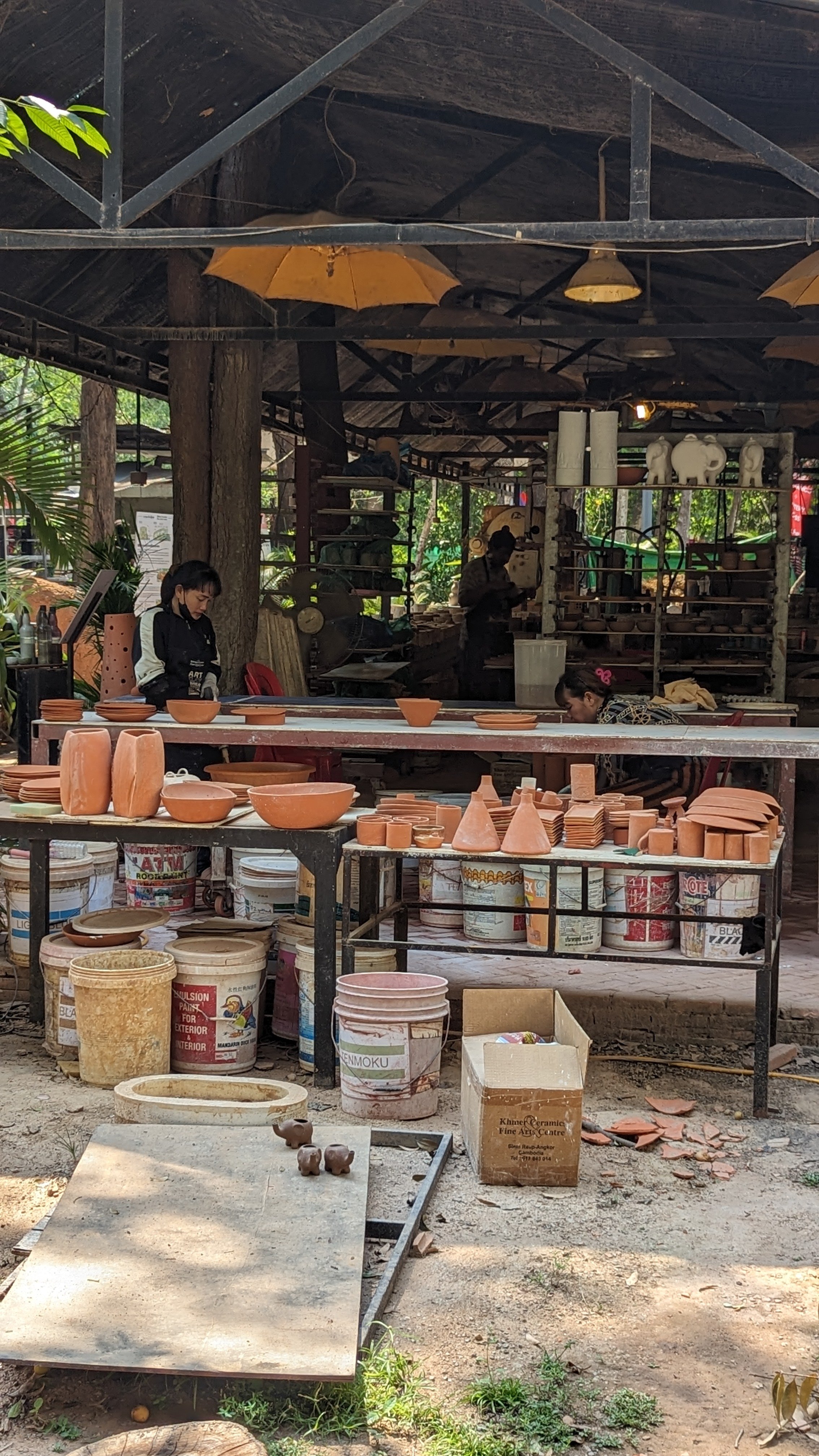ON THE CERAMIC ROAD
CAMBODIA
Member and new Board President Cheryl Stevens shares her impressions of her recent trip to the Khmer Ceramics Studio in Cambodia.
On a recent trip to Cambodia, after visiting Angkor Wat and the Bayon Temple, I decided to stop by and see how Cambodian ceramics are made. So on one hot afternoon my knowledgeable and accommodating guide, Dahlign, took me to Khmer Ceramics & Fine Arts Center. Khmer Ceramics is a very modest operation, but it has played a pivotal role in Cambodian ceramics. As soon as you enter you will find the huge pug mill on the left where the clay is reclaimed and prepared for the potters. On the right are the various kilns used in the production of their signature products sold on-site. In addition to a gas kiln, Khmer relies on a wood kiln that is undergoing its third reconstruction and fires to 1300 degrees Celsius.
Located close to the historic temples of Angkor – the cultural, spiritual, and artistic heart of Cambodia – Khmer Ceramics blends a passion for ceramics and Khmer history with a desire to create opportunities for the local community of Siem Reap.
As I walked through the garden studio, I was able to observe several women glazing pieces fresh out of the kiln while others were loading the gas kiln and another pair conducted a wheel class for a group of tourists in the back of the garden studio. Everything seemed so familiar except for the 95-degree temperature with 80 % humidity. I could have been in Berkeley instead of Siem Reap because one thing for sure pottery is the same no matter where you are in the world.
Although Khmer Ceramics is not as old as The Potter’s Studio it has its own important legacy. Khmer Ceramics & Fine Arts Center was founded in 2006 and began with the name of ‘’NCKCR’’ (the National Centre for Khmer Ceramic Revival) a non-profit, non-governmental organization with the aim of revitalizing the Cambodian ceramics industry. Khmer Ceramics Center was established to spread the word about Cambodian arts internationally while helping local potters benefit from the knowledge of outside experts in the ceramics field, with the goal of creating a sustainable local industry.
The Center works with the local community and seeks to create educational and training opportunities, especially for disadvantaged groups, such as single mothers, people with little or no schooling, low-income groups and people with disabilities. DEI is in action and definitely instrumental to the Center’s mission. “Sadly, so much of Cambodia’s cultural heritage and artistic knowledge was lost during the dark days of the Khmer Rouge, the country is now rebuilding itself after years of war and suffering.” Khmer Ceramics has stepped right up to ensure that Cambodia’s artistic heritage is preserved and maintained, and that knowledge is spread and passed down from generation to generation. I saw for myself the aftermath of decades of war and repression and learned that much of Cambodia’s once-rich cultural and artistic heritage has been lost: historic sites have been looted, artwork has been smuggled abroad and knowledge of traditional crafts has declined. For almost two decades Khmer Ceramics has been working to rebuild Cambodia’s artistic legacy.
The efforts have paid off. Today, Khmer Ceramics and Fine Arts Centre employ more than 60 people directly, 75% of them women, as well as providing an outlet for the works of many other local artisans, including villagers near Siem Reap who weave baskets and palm leaf boxes, produce handmade wood and stone carvings, and make natural jewelry. (I even bought a pair of earrings.)
“The Center focuses predominantly on handmade traditional Khmer art, particularly the tradition of Kbach, which is most evident in the stone carvings of the Angkor temples and at other historic sites around the country. Kbach-style ceramics are carved with representations of a variety of shapes found in nature such as lotus petals, leaves, flames and water, each of which has a particular meaning and can be used to tell a story,” “The Center produces tableware, such as cups, plates and bowls, in the kbach style, (kbach or Khmer ornamentation is made of traditional decorative elements found in Cambodia architecture and all kbach shapes refer to natural elements that reflect the laws of rhythm and balance presiding over the harmonious composition of a whole) including stoneware representations of Buddha, Ganesh and Apsara dancers.”
Khmer Ceramics has also brought innovation to the Cambodian ceramic industry. They have expanded from one wood-fired kiln to gas-fired kilns and advanced production techniques, helping to raise the quality of its products while maintaining traditional processes and styles.
I was delighted to include a visit to the Khmer Ceramic & Fine Arts Center on my recent trip to Cambodia and discovered that clay is truly a universal language.

















